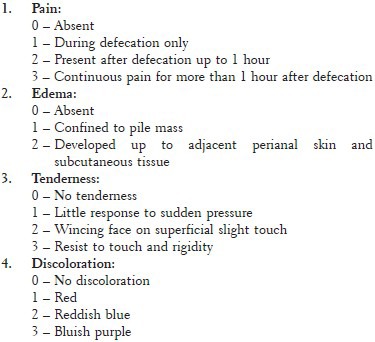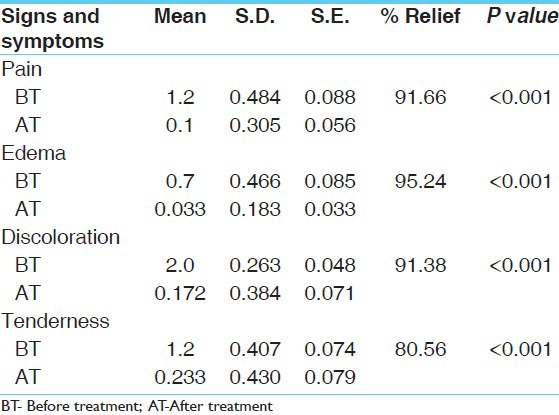Abstract
‘Arsha’ (hemorrhoids) is an ailment that affects all economical groups of population. Though the disease is within the limits of management, it has its own complications like severe hemorrhage, inflammation, and thrombosis, by which a patient gets severe pain and is unable to continue his routine work. Prior to surgical treatment of hemorrhoids, associated conditions like inflammation, strangulation, thrombosis, etc. need to be managed. Thrombosed piles possibly occur due to high venous pressure associated with severe anal pain. Leech (Hirudina medicanalis) application is found to be effective in reducing pain. In thrombosed piles, leech application has shown thrombolytic action, which contributes in re-establishment of circulation. It is observed in the study that, pus and mucous discharge have been reduced after leech application; which may be due to antimicrobial and mucolytic properties of leech. This method of treatment is found to be effective and increase the quality of life in patients suffering with thrombosed piles.
Keywords: Arsha, hemorrhoids, Jalaukavacharana, thrombosed piles
Introduction
Ayurveda the Indian system of medicine comprises of eight different specialties in which Shalyatantra, the surgical school of thoughts has got prime importance. Acharya Sushruta, father of surgery has considered Arsha (hemorroids) in Ashtaumahagada (eight major diseases). The incidence of hemorroids is common among all economical classes of population. Though the disease is within the limits of management, it has its own complications like sever hemorrhage, strangulation, thrombosis, etc. Thrombosed piles possibly occur due to high venous pressure causing severe pain that leads to a tendency of avoiding defecation, leading to hardening of stools causing constipation, which further exacerbates bleeding.[1] Hence its management in initial stages will become mandate.
Acharya Sushruta has considered four curative measures for the treatment of Arsha (hemorrhoids).[2]
Bheshaja
Kshara Karma
Agni Karma
Shastra Karma
Sushruta has indicated Visravana or Raktamokshana (bloodletting) in the management of hemorrhoids.[3] It has been explained that, in prolapsed (Nirgatani) and thrombosed (Doshapurnani) piles; Raktamokshana is the choice of treatment, which relieves pain.[4] Raktamokshana can be carried out with the help of Jalauka (leech) or any other suitable method.[5]
Surgery is contradicted if the hemorrhoids are associated with secondary complications like thrombosis.[6] Hence effective method for the treatment of thrombosed piles as well as to minimize the post-operative complications becomes necessary. It had given a scope to evaluate the role Jalaukawacharana in the management of thrombosed piles. The effect of bloodletting (Raktamokshana) through leech therapy (Jalaukawacharana) on thrombosed externo-internal piles (Raktarsha or Sravi Arsha) has been studied in the current attempt.
Materials and Methods
The patients were selected from the outpatient department (OPD) and inpatient department (IPD) of Shalyatantra, Government Ayurved College and Hospital, Nagpur, Maharashtra. Total 12 patients of all age groups of either sex with signs and symptoms of externo-internal thrombosed piles were included in the study.
Plan of work
Necessary laboratory investigations were carried out before treatment. Twelve patients had undergone for leech application with a gap of 2 days between two settings. Follow up was done for 3 weeks.
Leech application
Purva Karma: The application site was cleaned and dried.
Pradhana Karma: Leech was made to catch on the place of pile mass. If necessary, pile mass was pricked with needle to bleed, so that it gets easy to catch by the leech.[7] Out of 12 patients, 11 noticed pain and itching at the time of sucking blood by the leech.
Paschat Karma: The part should be cleaned with cold water followed by application of honey or Shatadhauta Ghrita with dressing.[8]
Criteria of assessment

Observations and Results
Total ratio for male to female was 3:1. Age wise distribution shows that most of the patients were from the age group of 21–40 years. Follow up was done for 3 weeks. All observations were noted and statistically represented, which shows significant results Table 1. Pain was relieved within 7 days of leech application in eight patients, whereas in 15 days of leech application edema, discoloration, and tenderness were reduced in maximum number of patients. Two patients after leech application showed uncontrolled bleeding; hence, care should be taken during the procedure. Maximum number of patients started regular work within a month.
Table 1.
Effect of therapy on signs and symptoms of

Effect of Jalaukawacharana on pain: The score of pain before treatment was 1.2, whereas after treatment it was reduced to 0.1. Percentage of pain relief was found 91.66%.
Effect of Jalaukawacharana on edema: The score of edema before treatment was 0.7, whereas after treatment it was reduced to 0.0333 with 95.24% relief.
Effect of Jalaukawacharana on discoloration: The score of discoloration before treatment was 2, whereas after treatment it was reduced to 0.1724 with 91.38% relief.
Effect of Jalaukawacharana on tenderness: The score of tenderness before treatment was 1.2, whereas after treatment it was reduced to 0.233 with 80.56% relief [Table 1].
Discussion
Engorgement of a hemorrhoidal vessel with acute swelling may allow blood to pool and, subsequently, clot; this leads to the acutely thrombosed external hemorrhoid (TEH), a bluish-purplish discoloration often accompanied by severe incapacitating pain.
Raktamokshana is practiced in India since thousands of years, which has been included under the five bio-purificatory procedures. Leech application is one type of bloodletting in Ayurveda. Hirudin present in the saliva of leech helps in oppressing the process of blood clotting.
One leech exhausts from 5 to 10 ml of blood. Bleeding lasts for some hours (about 12–24 hours) and patient loses about 20–30 ml of blood. Thus due to influence of 5 leeches simultaneously a patient loses 100–250 ml of blood. Biologically active substances containing in saliva glands of medicinal leeches can restore blood circulation in the nidus of inflammation, removes ischemia of organs, and provide capillary tissue exchange and, due to it, can carry out the transport of chemical drugs into the nidus of inflammation, improve immune protection, and regeneration of tissues.
Probably, due to the action of hirudin and hyaluronidaze (the factor of penetration) it improves not only the blood circulation in organs, but also in other organs and tissues due to the best capacity of capillary-tissues exchanging and so on. It promotes reduction of swelling, dissolution of the organized blood-clots, and cosmetic effect. Using of leeches promotes the increasing of local immunity as well. The leech application is effective in reducing the pain; this supports the analgesic action of leech component. In thrombosed piles, the leech application has thrombolytic action. The pus and mucous discharge also get subsided due to leech application, this effect is due to antimicrobial and mucolytic properties of leech.[9]
Conclusion
In present study, the leech application in case of thrombosed piles is found to be effective. This application provides analgesic and thrombolytic activities. Decrease in pus and other discharges can be expected because of the antimicrobial and mucolytic properties of leech. In addition to these benefits; the method is cost effective, less time consuming and an OPD procedure.
References
- 1.Das S. A Concise Textbook of Surgery. 6th ed. Kolkata: Dr. S. Das, 13, Old Mayors’ Court; 2010. p. 959. [Google Scholar]
- 2.Sushruta . Sushrutasamhita, Chikitsasthana, Arshachikitsa Adhyaya, 6/3. 3rd ed 1972. [Google Scholar]; Shastri Kaviraj Ambikadatta. Varanasi: Chaukhamba Sanskrit Sansthan; [Google Scholar]
- 3.Ibidem. Sushrutasamhita, Chikitsasthana, Arshachikitsa Adhyaya 6/7.
- 4.Ibidem. Sushrutasamhita, Sutrasthana, Shonitvarnaniya Adhyaya 14/33.
- 5.Ibidem. Sushrutasamhita, Sutrasthana, Jalaukawacharaniya Adhyaya 13/3.
- 6.Bhat SM. SRB’s Manual of Surgery. 3rd ed. Panama: Jaypee Brothers Medical Publishers (P) Ltd; 2009. [Google Scholar]
- 7.Sushruta . Sushrutasamhita, Sutrasthana, Jalaukawacharaniya Adhyaya, 13/19-21. 3rd ed 1972. [Google Scholar]; Kaviraj Ambikadatta Shastri., editor. Varanasi: Chaukhamba Sanskrit Sansthan; [Google Scholar]
- 8.Ibidem. Sushrutasamhita, Sutrasthana, Jalaukawacharaniya Adhyaya 13/23.
- 9.Srivastava A, Sharma R. A brief review on applications of leech therapy. Arch Apll Sci Res. 2010;2:271–4. Available from: (http://wwwscholarsresearchlibrarycom/archivehtml. ) [Google Scholar]


